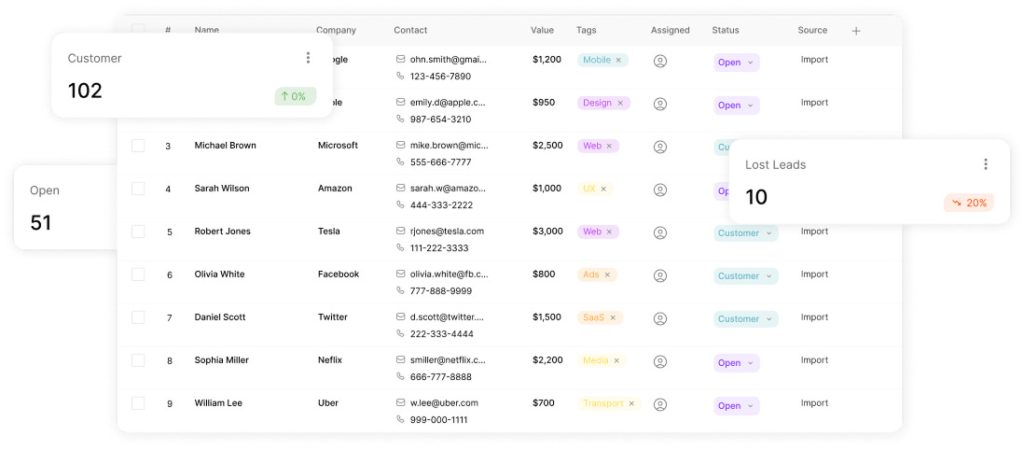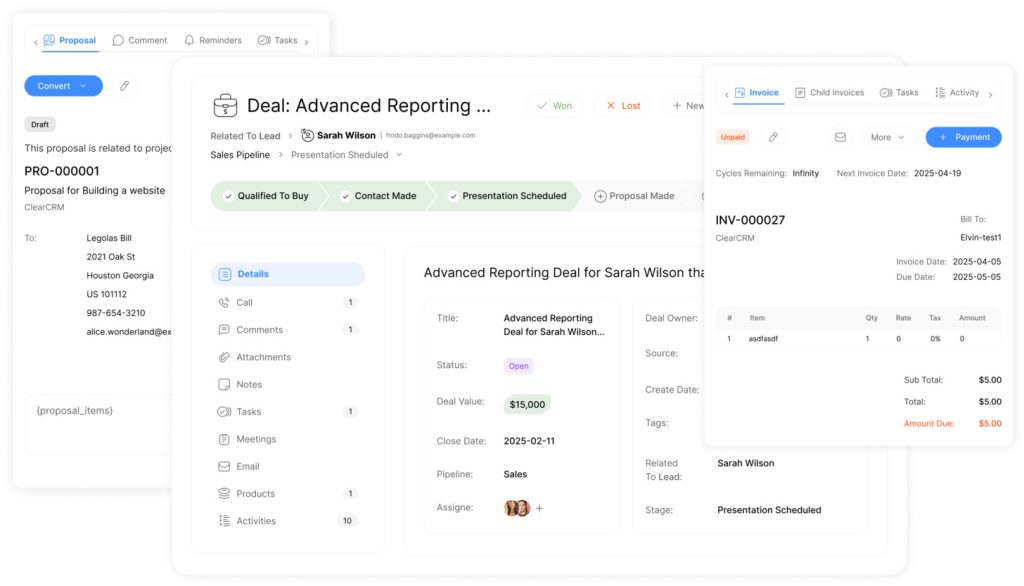Detailed Lead Activity Tracking for Marketing Success

In today’s competitive business landscape, understanding the customer journey is crucial for converting potential customers into loyal buyers. Lead tracking serves as the backbone of this process, enabling businesses to monitor prospect interactions and make data-driven decisions.
Effective lead tracking involves capturing, organizing, and analyzing prospect data to optimize sales and marketing strategies. By implementing a structured lead tracking process, businesses can gain comprehensive visibility into their sales pipeline, identify areas for improvement, and drive revenue growth.
Key Takeaways
- Understand the importance of lead tracking in business growth.
- Learn how to capture, organize, and analyze customer interactions.
- Discover the benefits of using lead tracking data to optimize sales and marketing strategies.
- Implement a structured lead tracking process to drive revenue growth.
- Gain insights into the customer journey and improve conversion rates.
Understanding Lead Activity Tracking

Lead activity tracking is a vital component of modern sales and marketing strategies, enabling businesses to make data-driven decisions. By capturing data on how leads interact with your brand over time, businesses can gain valuable insights into customer behavior and preferences.
What Is Detailed Lead Activity Tracking?
Detailed Lead Activity Tracking represents the systematic process of monitoring and documenting every interaction potential customers have with your business throughout their buying journey. This includes capturing data on website visits, email opens, social engagement, and other activities. By creating a chronological record of prospect touchpoints, businesses can transform scattered interaction data into structured intelligence.
- Capture mechanisms to collect lead interaction data
- Engagement monitoring to track lead behavior
- Progress documentation to record lead movement through the sales funnel
Lead Tracking vs. Lead Management vs. Lead Scoring
While often used interchangeably, lead tracking, lead management, and lead scoring are distinct concepts. Lead tracking is about capturing data on interactions, whereas lead management is the broader process of organizing and nurturing those leads through the sales funnel. ClearCRM is an example of a tool that can facilitate effective lead management. Lead scoring involves ranking leads based on their likelihood to convert, using a combination of behavioral and profile data.
Understanding these distinctions is crucial for implementing an effective lead tracking process that aligns with your overall sales and marketing strategy. By leveraging the right tools and techniques, businesses can enhance their customer journey visibility and drive more conversions.
Why Detailed Lead Activity Tracking Is Essential for Business Growth
Detailed lead activity tracking is the backbone of a successful business strategy, providing insights that drive informed decisions. By understanding how leads interact with their brand, businesses can refine their marketing efforts and improve sales efficiency.
Visibility Into the Full Customer Journey
Comprehensive lead tracking provides visibility into the complete customer journey, revealing which marketing campaigns generate qualified leads and identifying where prospects typically disengage. This insight enables businesses to fine-tune their marketing strategies and optimize the customer experience.
Data-Driven Decision Making
Lead tracking transforms raw data into actionable intelligence that enables more confident, evidence-based decision making across marketing and sales departments. By leveraging data on lead behavior and engagement, businesses can make informed decisions that drive growth.
Improved Sales Forecasting and Resource Allocation
Accurate lead tracking improves sales forecasting precision by replacing guesswork with behavioral patterns and engagement metrics that reliably predict conversion likelihood. This enables businesses to allocate resources more strategically, focusing on high-performing channels and tactics.
| Benefits of Lead Tracking | Description | Impact on Business |
|---|---|---|
| Visibility into Customer Journey | Understanding lead interactions and drop-off points | Improved marketing strategies and customer experience |
| Data-Driven Decision Making | Transforming raw data into actionable insights | More confident decision making across departments |
| Improved Sales Forecasting | Predicting conversion likelihood based on lead behavior | Strategic resource allocation and improved sales efficiency |
Key Components of an Effective Lead Tracking System
The foundation of any successful sales strategy is a well-designed lead tracking system. This system is crucial for monitoring and analyzing lead interactions, thereby enabling businesses to make informed decisions. An effective lead tracking system comprises several key components that work together to streamline the sales process.
Lead Capture Mechanisms
Capturing leads is the first step in the lead tracking process. Businesses can capture leads through various channels such as web forms, chatbots, social media ads, events, phone calls, or direct outreach. The key is to capture contact details and source information from every channel where leads come in. For more insights on effective marketing strategies, visit ClearCRM’s marketing page.
Engagement Monitoring Tools
Once a lead is in the system, tracking their interactions is vital. Engagement monitoring tools help businesses understand how leads are interacting with their brand across different channels. This includes monitoring email opens, page visits, and product demo views, which reveal interest levels and buying intent.
Communication History Documentation
Maintaining a comprehensive record of all interactions with a lead is essential. This communication history documentation creates a single source of truth, enabling sales teams to understand the lead’s journey and tailor their approach accordingly.
| Component | Description | Benefits |
|---|---|---|
| Lead Capture Mechanisms | Web forms, chatbots, social media ads | Captures lead information from multiple channels |
| Engagement Monitoring Tools | Email tracking, page visit monitoring | Reveals lead interest and buying intent |
| Communication History Documentation | Recording all lead interactions | Provides a comprehensive lead history |
| Lead Scoring Implementation | Assigning scores based on lead behavior | Helps prioritize leads for sales teams |
| Progress Tracking Features | Visual representations of lead movement | Highlights bottlenecks and acceleration points |
Lead Scoring Implementation
Lead scoring transforms raw engagement data into prioritization frameworks. By assigning scores to leads based on their behavior and interactions, businesses can help sales teams focus on the most promising opportunities.
Progress Tracking Features
Finally, progress tracking features provide visual representations of lead movement through defined sales stages. This helps in identifying bottlenecks and acceleration points in the conversion process, enabling businesses to optimize their sales strategies.
Setting Up Your Detailed Lead Activity Tracking Process

Implementing a detailed lead activity tracking process is crucial for businesses aiming to optimize their sales and marketing efforts. To get started, businesses need to establish a clear framework that aligns with their specific objectives.
Defining Your Lead Stages and Sales Funnel
Before implementing a lead tracking system, it’s essential to define your lead stages and sales funnel clearly. This involves aligning your marketing and sales teams on the stages a lead goes through, such as new lead, Marketing Qualified Lead (MQL), Sales Qualified Lead (SQL), and closed deal. Clear definitions help with accurate tracking, reporting, and handoffs between teams.
Standardizing data entry is also crucial. Inconsistent lead information can disrupt tracking. Using dropdowns, automation, and required fields can maintain clean, structured data across your CRM or lead tracking system.
Selecting the Right Lead Tracking Tools
Choosing the appropriate lead tracking tools is vital for the success of your tracking process. When selecting tools, consider factors such as business size, complexity, integration capabilities, and scalability requirements. The best lead tracking software for small businesses should offer ease of use, robust features, and seamless integration with existing systems.
Integrating Your Marketing and Sales Systems
Integrating your marketing automation platforms with CRM systems is critical for creating a seamless data flow and eliminating information silos. This integration enables businesses to track leads effectively, from initial contact to conversion. By ensuring that both marketing and sales teams have access to the same data, businesses can improve collaboration and enhance the overall customer experience.
Advanced Lead Tracking Strategies for Maximum Conversion

To maximize conversion rates, businesses must adopt advanced lead tracking strategies that leverage cutting-edge technology and data science. By doing so, companies can gain a deeper understanding of their leads’ behavior and preferences, ultimately driving more sales and revenue.
Leveraging AI and Machine Learning
Artificial intelligence (AI) and machine learning (ML) are revolutionizing lead tracking by enabling businesses to analyze vast amounts of lead data, predict conversion likelihood, and automate lead scoring. AI-powered lead tracking can help businesses respond to leads faster and more accurately, improving overall conversion rates. For instance, AI can analyze historical lead behavior patterns to predict future conversion likelihood, allowing businesses to prioritize high-value leads.
Multi-Channel Data Integration
Effective lead tracking requires integrating data from multiple channels, including websites, email, social media, phone calls, and in-person events. By consolidating this data, businesses can create unified customer profiles, gaining a more comprehensive understanding of their leads’ interactions and preferences. Multi-channel data integration enables businesses to identify patterns and trends that might be missed through traditional tracking methods.
| Channel | Data Collected | Insights Gained |
|---|---|---|
| Website | Page views, time on site, bounce rate | Lead engagement, content effectiveness |
| Open rates, click-through rates, conversion rates | Lead interest, campaign effectiveness | |
| Social Media | Engagement rates, follower growth, sentiment analysis | Lead sentiment, brand awareness |
Personalization Based on Tracking Insights
By leveraging tracking insights, businesses can personalize their marketing messages and sales outreach, improving lead engagement and conversion rates. Personalization enables businesses to tailor their approach to individual leads, increasing the likelihood of conversion. For example, businesses can use tracking data to identify leads who have abandoned their shopping carts and send targeted follow-up emails to re-engage them.
“The key to successful lead tracking is not just collecting data, but using that data to create a more personalized and engaging experience for your leads.”
By implementing these advanced lead tracking strategies, businesses can maximize their conversion rates, driving revenue and growth. As the marketing landscape continues to evolve, it’s essential for businesses to stay ahead of the curve by adopting cutting-edge lead tracking technologies and techniques.
How to Track Sales Qualified Leads Effectively

The ability to identify and track sales qualified leads (SQLs) effectively is a key determinant of sales success. SQLs are prospects that have demonstrated both fit and readiness to purchase, making them high-priority targets for sales teams.
Establishing Clear Qualification Criteria
To track SQLs effectively, businesses must first establish clear qualification criteria based on demographic fit and behavioral indicators. Frameworks like BANT (Budget, Authority, Need, Timeline) or CHAMP (Challenges, Authority, Money, Prioritization) are commonly used to define what qualifies a lead as ‘sales ready’.
Implementing Lead Scoring Models
Lead scoring models are crucial for identifying SQLs. By assigning scores or labels to leads based on firmographic data and engagement signals, businesses can accurately determine which leads are ready for sales follow-up. For instance, a lead that has visited the pricing page, downloaded a product brochure, and attended a webinar might receive a high score, indicating they are sales qualified.
Automating SQL Identification and Routing
Automating the identification and routing of SQLs ensures timely follow-up by appropriate sales team members. By configuring automated systems, businesses can quickly respond to SQLs, increasing the likelihood of conversion. A well-implemented automation system can also provide valuable insights into sales performance and lead conversion rates.
| Qualification Criteria | Description | Example |
|---|---|---|
| Demographic Fit | Company size, industry, job title | Enterprise companies in the finance sector |
| Behavioral Indicators | Product usage, website visits, content downloads | Repeated visits to the pricing page, downloading product brochures |
| Lead Scoring | Assigning scores based on demographic and behavioral data | Score of 80+ indicates a sales qualified lead |
By implementing these strategies, businesses can enhance their ability to track SQLs effectively, leading to improved sales conversion rates and more efficient sales processes.
Best Practices for Detailed Lead Activity Tracking
Effective lead tracking is crucial for business success, and implementing best practices can significantly enhance your lead management process. By adopting these practices, businesses can ensure that their lead tracking system is optimized for maximum efficiency and effectiveness.
Standardizing Data Entry Across Teams
Standardizing data entry across marketing and sales teams is vital for maintaining consistent and reliable lead information. Using a CRM or lead tracking software to assign scores or labels to SQLs (Sales Qualified Leads) helps in prioritizing leads based on their engagement and firmographic data. For instance, a VP-level lead from a target industry who has downloaded a pricing guide should be ranked higher than a junior employee who only visited the homepage.
Automating Repetitive Tracking Tasks
Automation plays a key role in enhancing the efficiency of lead tracking by reducing manual errors and saving time. Tools like HubSpot, Salesforce, and Usermaven allow businesses to set rules or conditions that automatically mark leads as sales qualified when they meet certain thresholds. This ensures that no hot lead is overlooked and enables sales teams to respond promptly.
Regular Review and Optimization of Tracking Processes
Regularly reviewing and optimizing lead tracking processes is essential for adapting to changing market conditions and evolving buyer behaviors. This involves assessing the effectiveness of current tracking protocols, identifying areas for improvement, and making necessary adjustments. By doing so, businesses can ensure that their lead tracking system remains aligned with their sales and marketing objectives.
| Best Practice | Description | Benefits |
|---|---|---|
| Standardizing Data Entry | Using CRM or lead tracking software to assign scores or labels to SQLs based on engagement and firmographic data. | Consistent and reliable lead information, improved lead prioritization. |
| Automating Repetitive Tasks | Using automation tools to mark leads as sales qualified when they meet certain thresholds. | Reduced manual errors, increased efficiency, timely response to hot leads. |
| Regular Review and Optimization | Assessing and adjusting lead tracking processes to adapt to changing market conditions and buyer behaviors. | Improved alignment with sales and marketing objectives, enhanced lead tracking effectiveness. |
Common Lead Tracking Challenges and How to Overcome Them

Implementing a lead tracking system can be fraught with challenges, but understanding these hurdles is the first step to overcoming them. Businesses often face obstacles that can hinder the effectiveness of their lead tracking efforts.
Data Silos and Integration Issues
One of the primary challenges is data silos and integration issues. When lead data is scattered across different tools that don’t integrate well, it creates an incomplete view of the customer journey. To overcome this, businesses should choose tools that integrate with their CRM or marketing automation platform, ensuring that lead data flows into one central location. For instance, using a platform like ClearCRM can enhance customer management by providing a unified view of lead interactions.
Inaccurate or Incomplete Lead Data
Inaccurate or incomplete lead data is another significant challenge. This can lead to misinformed decisions and wasted resources. To address this, businesses can implement data validation techniques and enrichment strategies to improve the quality of their lead data. Ensuring that the data is accurate and comprehensive is crucial for effective lead tracking.
Low User Adoption Among Sales Teams
Low user adoption among sales teams can also hinder the success of lead tracking efforts. To increase adoption, businesses should provide training and incentives to their sales teams, demonstrating the value of the lead tracking system. By making the system user-friendly and showing its benefits, businesses can encourage higher adoption rates.
Balancing Automation with Personal Touch
Finally, balancing automation with a personal touch is a delicate challenge. While automation can streamline processes, it’s essential to maintain a personal connection with leads. Businesses should use automation to enhance their lead nurturing process without losing the human element that builds trust and rapport with potential customers.
Measuring the Success of Your Lead Tracking Efforts
By establishing clear metrics, businesses can evaluate the performance of their lead tracking initiatives and make informed decisions. Effective lead tracking requires a data-driven approach to measure its success and identify areas for improvement.
Key Performance Indicators for Lead Tracking
To accurately assess lead tracking success, businesses should focus on key performance indicators (KPIs) such as lead quality scores, conversion rates by stage, and attribution accuracy. These metrics provide valuable insights into the effectiveness of lead tracking efforts.
Creating Actionable Reports and Dashboards
Transforming complex tracking data into clear, decision-driving visualizations is crucial. Businesses can create actionable reports and dashboards that help stakeholders understand the impact of lead tracking on sales and marketing efforts. By leveraging these insights, businesses can optimize their lead tracking strategies and improve overall performance.
Conclusion: Transforming Your Business Through Detailed Lead Activity Tracking
As businesses continue to navigate the complexities of lead generation, the importance of detailed lead activity tracking cannot be overstated. By implementing a comprehensive lead tracking system, companies can create a virtuous cycle of continuous improvement in marketing effectiveness and sales efficiency.
This guide has highlighted how detailed lead activity tracking transforms lead generation from a volume-focused activity to a precision-driven strategy that maximizes conversion rates. With the right system in place, businesses gain superior visibility into the complete customer journey, enabling timely and personalized engagement.
To move forward, businesses should focus on optimizing their lead tracking capabilities and leveraging emerging technologies to stay ahead. Whether just beginning implementation or ready to optimize existing systems, companies can significantly enhance their sales efficiency and marketing effectiveness through detailed lead activity tracking.

